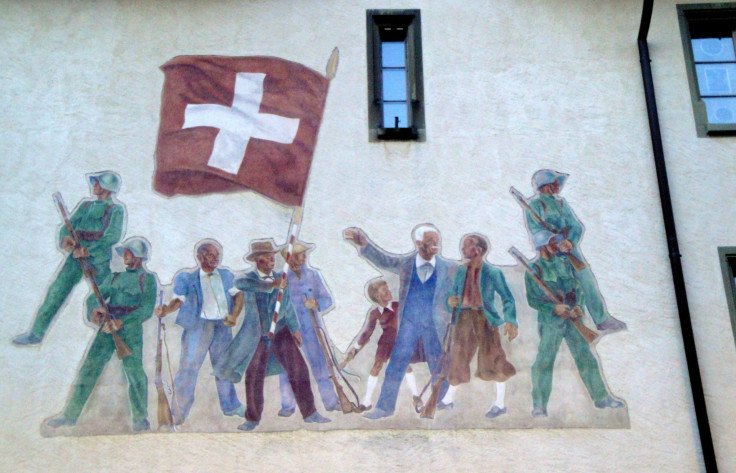Death In Quiet Towns: From Newtown To Switzerland, Gun Control Under Scrutiny

The picturesque Swiss village of Daillon lies just south of Wildhorn Mountain in the southern canton of Valais. Sloping streets are lined with old stone buildings and -- at this time of year -- white snow banks. Houses and shops are nestled into the hillsides. The place has a charming serenity, much like the centuries-old American town of Newton, Conn., did until just a few weeks ago.
Though separated by about 3,800 miles, the two hamlets are now linked by tragedy. On Wednesday, a gunman in Daillon murdered three women and injured two men around 9 p.m., shocking residents in the peaceful town and making international headlines.
Parallels to the Newtown shooting -- when 20-year-old Adam Lanza senselessly murdered 20 children and 7 adults before killing himself on Dec. 14 -- were obvious. Both assailants used multiple weapons. Both had some history of psychological health issues.
And both attacks took place in developed countries where gun ownership rates are higher than average.
For that reason, Switzerland has often been used as a point of comparison for the United States. Gun ownership figures are notoriously hard to pin down; in the United States, many guns are illegally acquired, and in Switzerland, there is no national register for firearms. But most studies put both countries near the top of a global list in terms of guns per capita.
However, unlike the United States, Switzerland’s violent crime rate is very low. According to a 2011 report from the UN Office on Drugs and Crime, the homicide rate (number of murders per 100,000 people) is five in the United States, which is more than seven times higher than Switzerland’s rate of 0.7.
Defenders of gun ownership in the United States often point to Switzerland as proof that the presence of guns doesn’t result in more violence. But that argument misses some crucial differences between Switzerland and the United States in regard to the nature of gun ownership in the two countries and the contrast between both countries’ societies.
In Switzerland, gun ownership is built into a sense of national duty. The country has no standing army; instead, males are conscripted into a sort of national militia for which females may volunteer. Each conscript is given a firearm that he or she may take home to keep, giving Switzerland what may be the highest gun ownership rate in Europe.
That’s why one eye-witness to the tragedy in Daillon told a local newspaper that she wasn’t initially surprised to hear gunshots.
“At first I didn't realize what was going on,” said Nathalie Frizzi, according to the BBC. “I thought children were shooting at cats and I called out for them to stop.”
But in accordance with laws implemented over the past few years, controls over gun use are tighter than they first appear. Many of Switzerland’s privately owned guns are not loaded since the government stores the ammunition in arsenals, for emergency use only. It has also been made illegal to carry guns in public, and background checks have become stricter.
In the United States, on the other hand, gun ownership does not always go hand-in-hand with military training, and most firearms are stored with ammunition at the ready. Gun stores require background checks for purchases, but the system is full of loopholes whereby consumers can get firearms via under-the-table transactions, or online.
The Newtown, Conn. shooter Adam Lanza took his guns from his mother, who was among his victims. The three weapons recovered from the scene of the school shooting had been legally purchased by her.
The Daillon shooter also seems to have come by his arms legally, though details on that case are still unfolding. According to the Associated Press, one of his weapons was a Swiss military rifle and the other was a handgun.
It is likely that this recent tragedy will spark some new debates on firearms violence and gun control in Switzerland, as it has in the United States. But the conversation in both countries will be very different. Switzerland is, after all, far more peaceful. Crime is rare.
In the United States, mass shootings are far more common. Newtown was preceded by a tragedy in Aurora, Colo., where James Holmes killed 12 people during a movie screening last July. Also in recent memory are the two 2009 shootings that each killed 13 people, one at an immigration services center in Binghamtom, N.Y., and the other at an army base in Fort Hood, Texas; the 2007 shooting that killed 32 people at the Virginia Tech campus; and the Columbine High School attack in Littleton, Colo., that killed 13 people in 1999.
As Daillon shows, violent attacks can happen anywhere. And when they do, they are cause for mourning and reflection. But frequent assaults, like the ones that have plagued the United States in recent years, are cause for action.
The American official response remains to be seen; Vice President Joe Biden is currently leading the charge in Congress to restrict civilian access to military-grade weaponry. In the meantime, a Swiss village is quietly reeling from its own unexpected tragedy in a country where yearly murders are measured in scores rather than thousands.
"We have no words to express ourselves after an event like this," said Christophe Germanier, a local politician, according to the AP.
“The year 2013 started badly. The day was sunny yesterday, but the evening was black.”
© Copyright IBTimes 2024. All rights reserved.






















